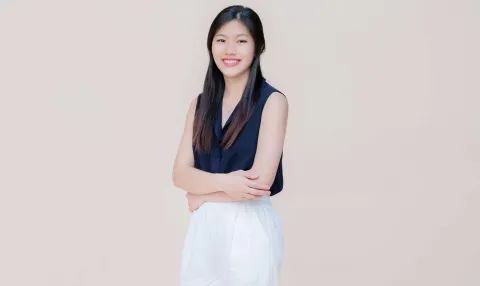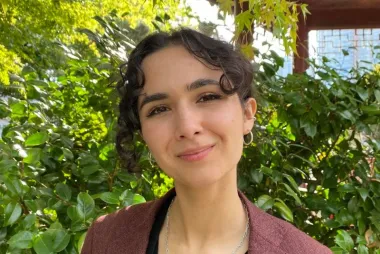"I aspire to design structures that foster symbiotic relationships between people, buildings and nature within our ever-growing world."

Rain Chen
- Degree:
- Bachelor of Design in Architecture, Landscape Architecture, and Urbanism
- Grad year: 2020
- Program:
- Campus: Vancouver
I graduated from UBC with an honours degree in Environmental Design. As someone who has consistently held an interest in the arts, I was always a creative person but struggled with how to realistically apply myself. The BEND program gave me the direction and motivation I craved. Its studio environment was a vigorous one and it constantly pushed me to better my designs, both technically and conceptually, and taught me crucial skills in critical thinking and wicked problem-solving.
Raised in densely populated Taiwan, my experience living in a concrete jungle has fueled my desire to explore more open, welcoming and interactive designs within compact housing. Having also worked in the sustainability sector for several years, I am continually working towards minimizing the negative environmental impact of buildings through both my design education and non-profit work.
I believe that our generation's actions will be pivotal in the preservation of our planet's environmental health. I aspire to design structures that foster symbiotic relationships between people, buildings and nature within our ever-growing world.
Why did you choose to go into your field of study at UBC?
When I first heard of the Environmental Design program, I was intrigued. What better way to combine my love of arts with my passion for sustainability? I quickly enrolled in Leslie Van Duzer's 'Thinking by Design' class (ENDS 231). It's a wonderfully designed course and I learned so much from each project. The teaching style was very different from what I was used to, and I loved it. It was my first taste of a studio environment.
However, I wasn't immediately accepted into the program. My first application was rejected. While initially disheartened, I now realize it was a blessing in disguise. I spent the next year bettering my technical design skills and taking on freelance projects, all while continuing my work with my non-profit organization, Project Imagine. When I re-applied, I was a stronger thinker, a better designer and properly equipped to handle the demanding nature of the program.
What has made your time at UBC memorable?
It's difficult to define single moments during my time in BEND as particularly memorable. I could say it was the moment I completed my first home design or the moment that design project was torn apart by external critics. Perhaps it was when I went to New York to compete in the BioDesign challenge, or how I came back thinking only of how incredible the architecture was there.
Leaving UBC now, I can say with confidence that every single moment in the program was a defining one. The opportunity to work alongside talented and likeminded individuals in a space solely dedicated to creative thinking was invaluable. We would work through the night, exchange endless streams of feedback and watch as our own hands brought our vision to life. All of it was priceless.
What has been your most valuable non-academic experience studying at UBC?
Founding Get Thrifty has made me who I am today.
Get Thrifty (a UBC campus thrift store) is the first and biggest project I commenced within my non-profit, Project Imagine Association. I started Get Thrifty the year I was accepted to BEND, hosting pop-up thrift stores monthly and doing everything I could with my team to bring a permanent thrift store to campus. I'm extremely proud to say that 2 years later, the first-ever permanent thrift store on campus was opened in Feb 2020, located in the UBC Life Building. With the help of my incredible team, I had the pleasure of personally designing and literally building the store.
Apart from BEND, almost everything I've learned at UBC was from leading Get Thrifty. I gained crucial interpersonal skills, design skills, project management skills and financial awareness from my time with Get Thrifty. I happily applied everything I learned from BEND to Get Thrifty, and vice versa. Moving forward, I will be taking a year off from school to continue to run and grow the store, as well as design its storefront expansion, before I pursue my Master of Architecture (hopefully also at UBC)!
Tell us about your experience in your program. What have you learned that is most valuable?
My time in BEND has taught me the judgement I needed to move forward. I learned not to take criticism personally. I began to recognize how to differentiate personal preference from objective feedback. I learned to self-critique, I learned to pace myself through time management and I learned that nothing is more important than my own mental and physical health. Being in such a competitive environment made it all too easy to forgo my self-care, but eventually I, along with everyone else in the program, quickly learned how unsustainable that was.
How are you applying the skills you learned through your studies at UBC?
I've become very focused on my goals and exactly how I want to achieve them. Less of my energy and time is wasted on inconsequential tasks or activities, leaving me more time to enjoy myself. As a naturally anxious person, this has proven invaluable.
What advice would you give a student entering your degree program?
Don't sacrifice your mental and physical health in order to excel (especially try to avoid sleep deprivation). It's not worth it and your performance will take hits that will prove difficult to recover from. Stay on the ball with time management, or you'll spend your entire program playing catch-up.
Learn to accept criticism and try not to take it personally. This will be difficult, as you will invest dozens of hours into a single project that will be critiqued and wrapped in 10 minutes or less.
Ask your studio classmates for peer reviews. You're in one of the most creative environments on campus - take advantage of it!
How do you feel your degree has benefitted you compared to a different field of study?
Before BEND, I was in Forestry. I quickly realized how little interest I had in the subject despite my interest in sustainable practices and it was because I wasn't designing anything. Being in this program has allowed me to evolve both creatively and practically.
Where do you find your inspiration?
There are numerous people I can attribute my inspiration to.
Leslie Van Duzer has always been a huge inspiration for me, especially as a woman in a male-dominated industry.
Travis Hanks challenged me to break out of my inherently straight-laced thinking pattern.
Bill Pechet inspired me to think whimsically and encouraged beauty in simplicity when it's so easy to become obsessed with complexity.
Graham Entwistle unfailingly guided me in times of bemusement regardless of if it was related to school or architecture.
What are your immediate and/or long-term plans for the future?
I plan to take a year off from school to continue to grow and design Get Thrifty as well as amass more working experience at architecture firms. Following that, I plan to return to school for my Masters of Architecture, though where I would apply to is yet to be determined.
What are your future plans to make a difference in our world?
I want to design homes for densely populated cities and make waves in how compact housing can be revitalized. I enjoy the challenge of making small spaces feel open and welcoming, and I want to apply my experience and passion for sustainability in my designs. Ultimately, I would love to open my own practice.
How has your identity informed your academic and professional experiences within your field at UBC and beyond?
As a POC and a woman, it is a daunting endeavour to effectively 'infiltrate' the white male-dominated industry of architecture. However, seeing the diverse spread of students in my program, I am feeling encouraged by the coming generation of architects.


